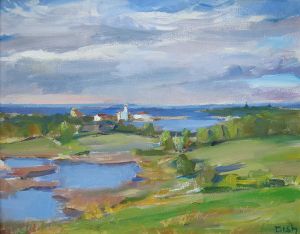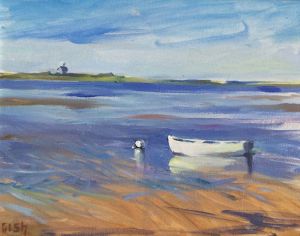Reflecting recently on his life as an artist, Gish emphasized the importance of being faithful to what the eyes see. “ I see better now than when I was younger,” he said. Most important to him is to capture “the essential thing, the emotional impact, of what is seen, the wonder of nature whatever it is — ash can, blossoms, sunsets …”
The vitality and variety of these new works are evidence of Gish’s vision. Grounded in what he calls the “craft of art,” they are works of intense colors and layers of subtle brushstrokes. Painted over the past year, they depict all the seasons and both the interior and exterior worlds that engage the artist. “Late Afternoon at North Light” is a seldom seen view of the lighthouse from the dunes north of the light. Warm light falls across the dunes in the foreground and casts dappled shadows along the path to the lighthouse in the distance. Deep indigo water on either side of the sand spit is repeated in the sky with its various hues of white, turquoise, and blue. In “Sunset at Watch Hill,” the colors are more intense, with the hot white disc of the setting sun igniting a blaze of red, purple, orange, and yellow along the horizon that is reflected in the deep blue and green water. Above, tendrils of clouds radiate outward in a swirl of white light against a sapphire sky.
In contrast, “Winter Gate” captures the cool winter light falling across a path to a snow-covered field. Long shadows of the gate post and rails are cast across the ruts in the snowy path. Winter light in “Atlantic Surf” emphasizes the deep green sea and white froth of waves crashing against rocks and foaming in pools in the foreground.
“Apple Tree in Blossom” couldn’t be more different. A familiar island apple tree is caught at its peak of bloom with the warm spring sunlight washing over the exuberant blur of the white, pink, and peachy tones of the blossoms. “Sunflowers” captures the warmth of a full summer sun in the deep yellow petal of two heavy-headed sunflowers bobbing against the cerulean sky. While Gish enjoys the challenge of painting from nature, he has a fondness for still lifes. “In a still life,” he said, “things don’t run away.” Nevertheless, Gish’s still lifes are full of energy and life. “Still Life with Veuve Cliquot” is a good example. Light gleams off a stainless steel pot and knife. The orange wine labels and the naval oranges are reflected in the pot, and the full wine glasses shimmer with anticipation of a toast about to be made. The dark bottles and background are foils for the reflected light, as is the streak of blue stripe in a white dish towel in the foreground. “I am following my muse,” Gish said about his life as an artist. His muse takes him and us into a world rich in color and light — what the poet William Blake called “eternal delight.”



















